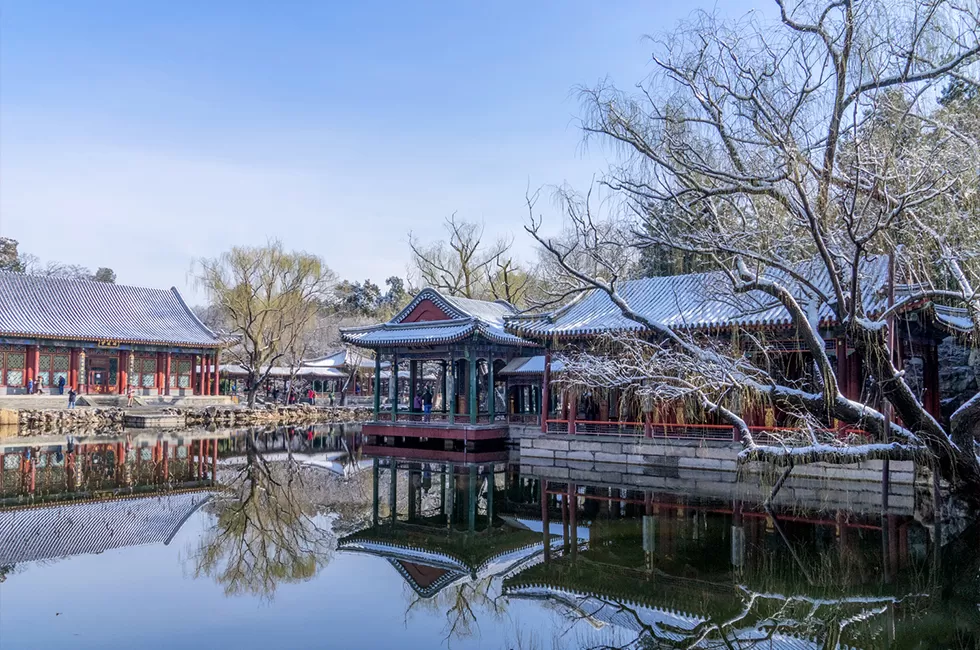Summer Palace, World Heritage Site
World Cultural Heritage Site: The Summer Palace in Beijing (1998)
Introduction
Located at the western suburb and 15 kilometers away from downtown Beijing, the Summer Palace is known as a world-famed royal garden that used to be called Qingyi Garden (literally translated as “the ripple garden”). After its renovation in 1888, it was given the new name commonly referred to today-the Summer Palace. It took 10 years to complete the renovation, involving an investment of 30 million teals of silver.
With an area of 293 hectares, the Summer Palace mainly consists of the Longevity Hill and the Kunming Lake. You can find over 3,000 royal garden architectures with various styles, which is roughly divided into three areas, particularly the administrative, the residential and the scenic area.
The administrative area, which centers the Hall of Benevolence and Longevity, used to the place where Empress Dowager Cixi assumed regency over Emperor Guangxu of the Qing Dynasty and received foreign guests. Behind the hall are three large courtyards, including the Hall of Happiness and Longevity, the Hall of Jade Ripples and Yiyun Hall, which used to be the homes of Cixi, Emperor Guangxu and concubines respectively. The Great Opera Hall on the eastern side of Yiyun Hall used to be one of three most famous opera houses back in the Qing Dynasty.
With your eyesight shifting from the Longevity Hill down to the Wisdom Hall, you will be able to find that the Tower of Buddhist Incense, Dehui Palace, the Cloud Dispelling Hall and the Decorated Paifang form an axis. At the foot of the hill is the Long Corridor that stretches 700 meters. The beams of the corridor are decorated with over 8,000 colored paintings, which contributes to its fame as the most charming corridor in the world. The corridor is located amidst the Kunming Lake, the western bank of which is said to mimic the Su Causeway of the West Lake in Hangzhou.
The back of the Longevity Hill is covered with verdant forests, with a quiet environment where Tibetan-style temples tower toward the sky. It is the also the place where you can take a stroll along the Suzhou Street. To the east of the lake is the Garden of Harmonious Pleasures, which is said to mimic the Jichang Garden in Suzhou. It is hailed as the garden of gardens for its small size and exquisite design.
The Summer Palace, a garden masterpiece rarely found elsewhere in the world, enjoys a position of influence in the world’s art of garden design for its original and exquisite design.
Cultural Heritages
The Summer Palace is divided into three areas, including the administrative area with the Hall of Benevolence and Longevity in the center, the residential area consisting of the Hall of Happiness and Longevity, the Hall of Jade Ripples and Yiyun Hall, and the scenic area composed of the Longevity Hill and the Kunming Lake. Such a large-scale garden is considered as a masterpiece of Chinese landscape garden design.
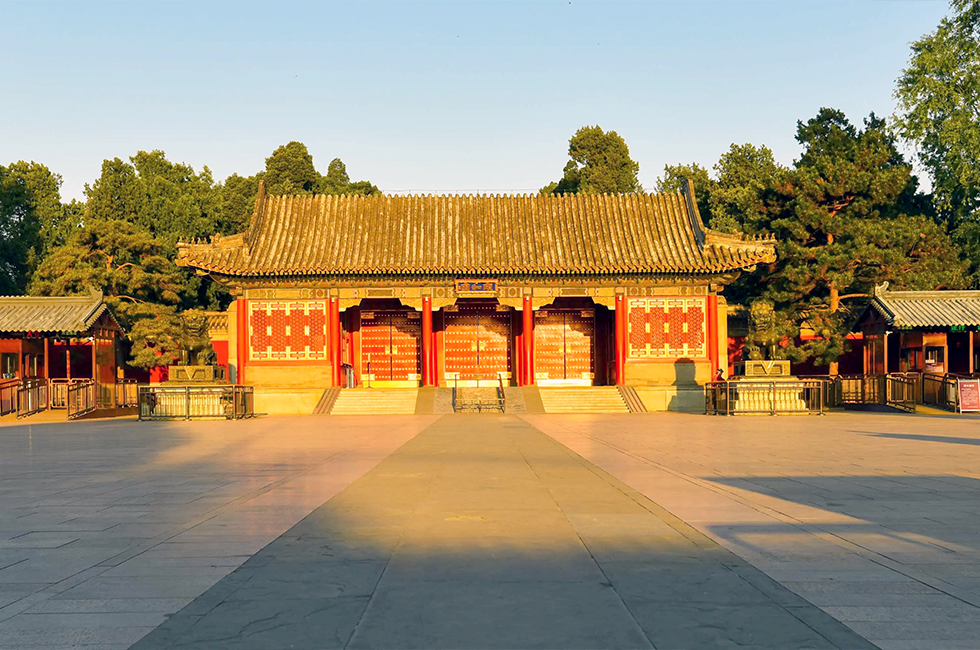 The East Gate
The East Gate1. The East Gate Area: On the eastern side of the garden, this area used to be the place where emperors of the Qing Dynasty lived and worked. It includes the Hall of Benevolence and Longevity and the South and North Halls which was where emperors met the government officials, the home, the Great Opera Hall and the courtyard. Today, the East Gate is the front entrance of the Summer Palace, which faces the east. The lintels under the eaves are painted with colorful patterns, while the six red doors are studded with yellow doornails, with a plaque hung over the door, on which there inscribes three golden Chinese characters Yi He Yuan (the Summer Palace). This plaque is said to be penned by Emperor Guangxu of the Qing Dynasty. The stairway in front of the gate is carved with a pattern of two dragons playing with a ball, which can be dated back to the Qianlong Period of the Qing Dynasty. It is said that this stairway was transported there from the remains of the Old Summer Palace. As a symbol of imperial authority, the East Gate was open for emperors back in the Qing Dynasty.
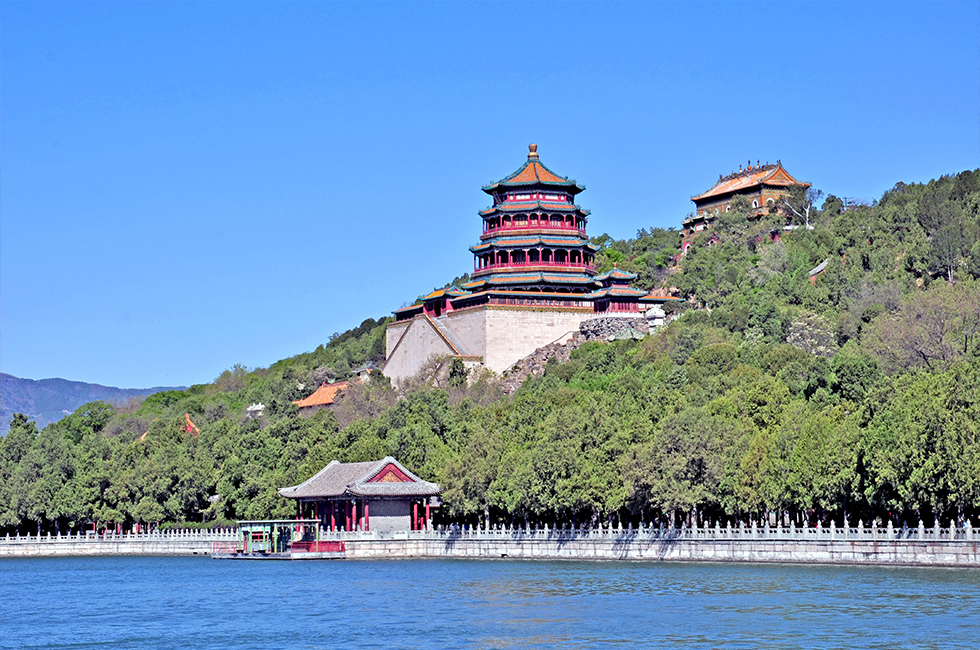 The Front Scenic Area of the Longevity Hill
The Front Scenic Area of the Longevity Hill2. The Front Scenic Area of the Longevity Hill: The overall structure of the scenic area features two horizontal and vertical axes crisscrossing each other at the center. The Long Corridor serves as the horizontal axis that stretches from the east to the west, while on the north-to-south axis, starting from the middle of the corridor, repose such buildings as the Cloud-Dispelling Gate, Ergong Gate, the Cloud-Dispelling Hall, Dehui Palace, the Tower of Buddhist Incense and the Wisdom Hall at the foot of the hill. The Longevity Hill was initially named the Golden Hill or Weng Hill, with a height of 109 meter. Located by the Kunming Lake in the south with the Tower of Buddhist Incense in the center, the hill forms a magnificent landscape in which the architectural structure has a unique charm. On the eastern side there are the Tibetan prayer wheels and the steles carved with the names of the Longevity Hill and the Kunming Lake. On the western side is Wufang Pavilion and the Pavilion of Precious Clouds. Ascending the top of the hill, you can overlook the scenery of Kunming Lake.
3. The Lake Area at the Back: On the northern region of the Summer Palace, this area features verdant thick forest and sparsely scattered buildings. Taking a stroll on the paths there will bathe you in a tranquil ambience. There, the Tibetan-style architectural complex and the Suzhou Street characterized by the lower regions of the Yangtze River that combine to give you a pleasant and interesting stay.
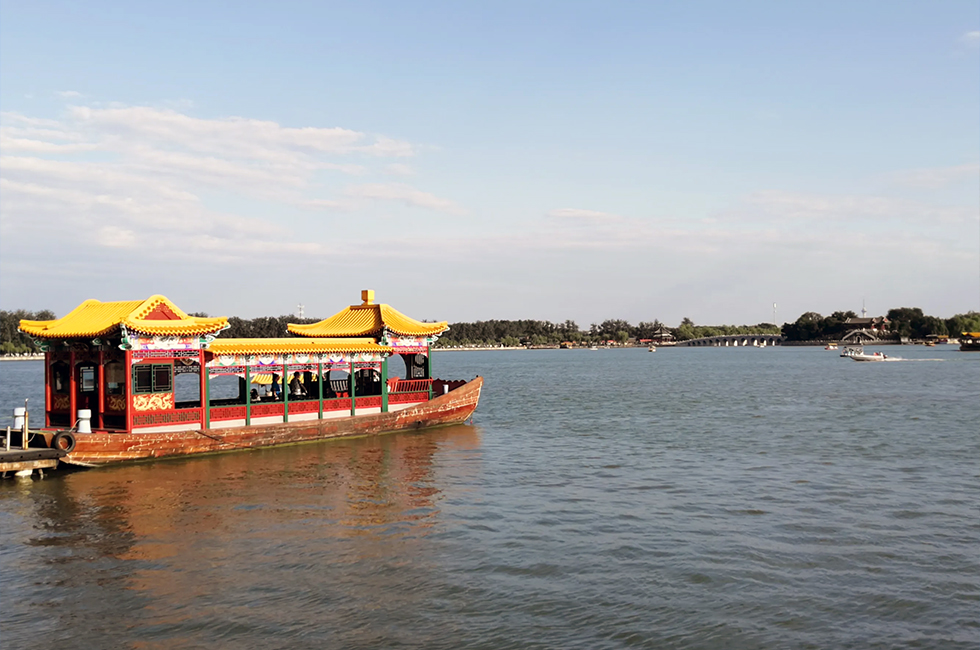 TThe Kunming Lake
TThe Kunming Lake4. The Kunming Lake: With a water surface area of about 220 hectares, the Kunming Lake accounts for three fourths of the total area of the garden. The front lake district in the south features glistening ripples that radiate in all directions. Having a look at the western side, you will be able to see the extending hills, while at the northern side, a magnificent architectural structure. In the lake there is the West Causeway, which is scattered with lines of willows. The 17-Arch Bridge crosses over the lake, and there are man ancient buildings of various styles on the three isles amidst the lake.
 The Tower of Buddhist Incense
The Tower of Buddhist Incense5. The Tower of Buddhist Incense: Located at the middle of the front part of the Longevity Hill, the Tower of Buddhist Incense is on a square base that is as tall as 21 meters. The 41-meter-tall tower is a triple-glazed structure that has 3 stories and comes in the shape of an octagonal prism, with 4 layers of eaves. Held up by 8 huge wooden pillars and featuring complex structures, it is hailed as a superb ancient building. The original tower was burnt down by the Anglo-French Allied Forces in 1860. The renovation of the tower started in 1897 (the 17th year during the reign of Emperor Guangxu) with an investment of 780,000 taels of silvers and completed in 1894. Such a revamp was the largest construction project in the Summer Palace. In the tower, a Buddhist statue was used to worship by the royal family members.
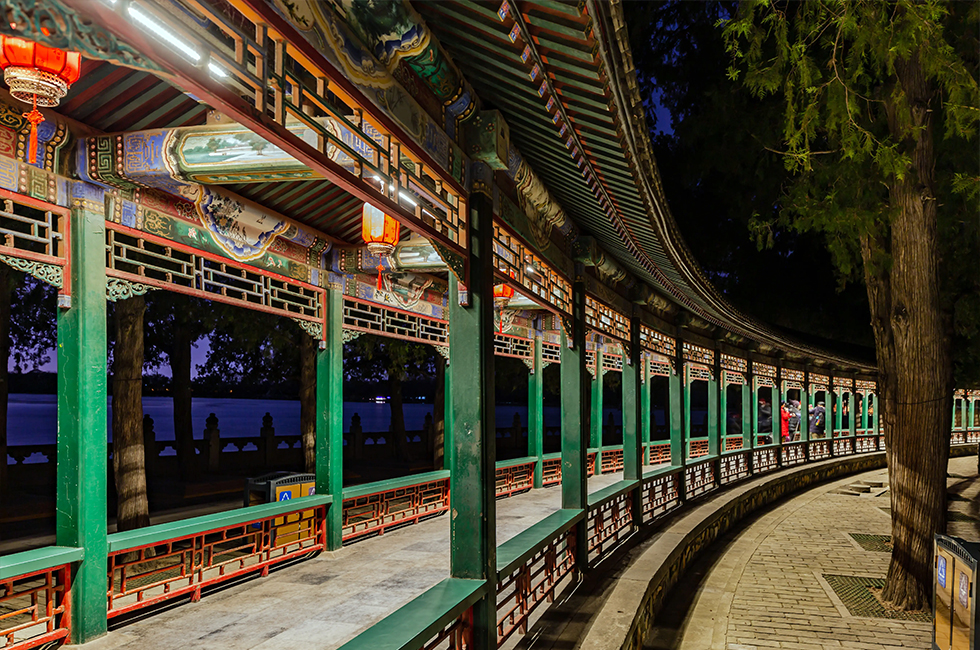 The Long Corridor
The Long Corridor6. The Long Corridor: Located at the southern foot of the Longevity Hill, the corridor faces the Kunming Lake, nestles the Longevity Hill in the north, starts from Yaoyue Gate and ends at Shizhang Pavilion, stretching 728 meters and housing 273 rooms, said to be the longest corridor in China in 1992. It was placed on the Guinness World Records as the longest corridor in the world. Each beam of the corridor is painted with colorful patterns, with altogether 14,000 paintings, the themes including landscape, birds, flowers and fish, and historic figures. The figures in the paintings derived from the ancient classics of Chinese literature.
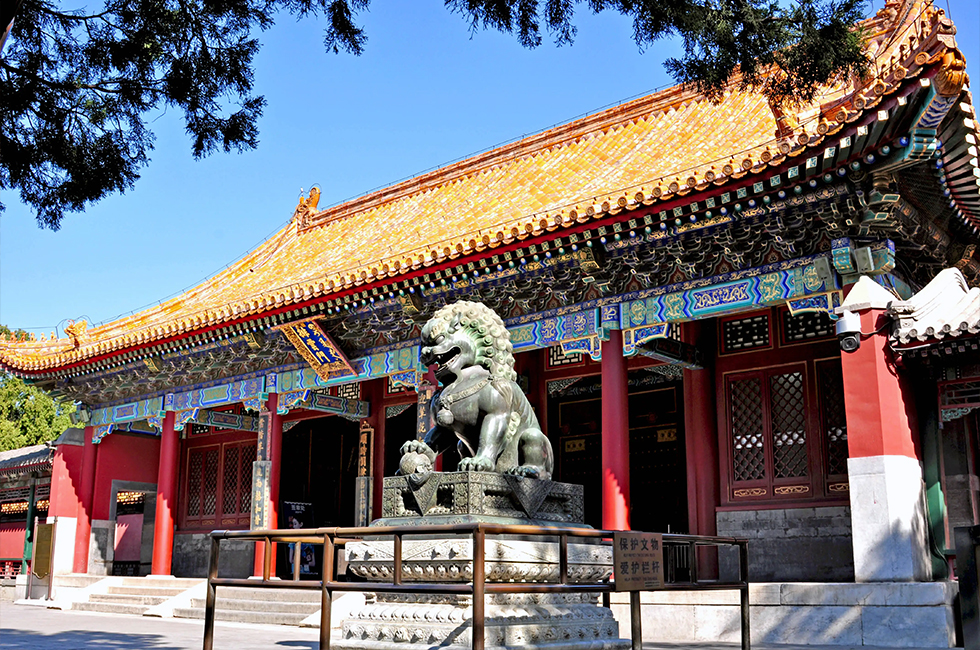 The Cloud-Dispelling Hall
The Cloud-Dispelling Hall7. The Cloud-Dispelling Hall: Situated right at the heart of the Longevity Hill architectural ensemble, the Cloud-Dispelling Hall was initially the Longevity Temple built for the 60th anniversary of Emperor Qianlong’s mother, and later changed to today’s name-the Cloud-Dispelling Hall. It used to be where Empress Dowager Cixi lived and received guests in her birthday celebrations. The idea of the name Could-Dispelling came from a poem by Guo Fu, a celebrated poet. This name may give one an impression that the hall is looming amidst the sea of clouds, which is thought to be frequented by immortals. Looked from the distance, the hall forms an ascending line together with the Decorated Paifang, the Cloud-Dispelling Gate, the Golden Water Bridge and the Ergong Gate. The Cloud-Dispelling Hall is said to be the most magnificent architectural ensemble in the Summer Palace.
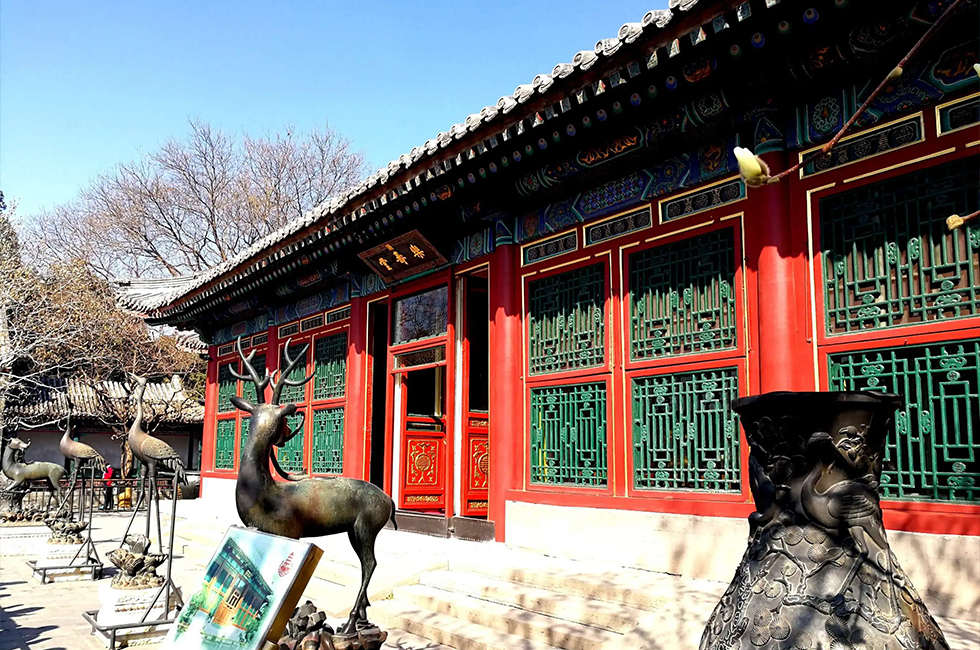 The Hall of Happiness and Longevity
The Hall of Happiness and Longevity8. The Hall of Happiness and Longevity: The hall is the main building of the residential area inside the Summer Palace. It was built in 1750 (the 15th year under the reign of Emperor Qianlong), destroyed in 1860 (the 10th year under the reign of Emperor Xianfeng), and revamped in 1887 (the 13th year during the reign of Emperor Guangxu). The hall faces the Kunming Lake and leans against the Longevity Hill, with the Hall of Benevolence and Longevity in its east and the Long Corridor in its west. It is the home of the best geographic location in the garden and the place for recreational activities. Inside the hall there is a throne, an imperial desk, palm fans and glass screens. By the throne there are two big porcelain plates carved with the pattern of two blue dragons, which used to contain fruits, and four big coppery furnaces for burning incenses. There two rooms inside, the bedroom in the western side and the dressing room in the eastern side. The red sandalwood closet can be dated back to the Qianlong Period.
In the courtyard of the hall display such items as a coppery deer statue, a coppery crane statue and a coppery vase, which, when combined, symbolize peace and stability. Also, there are precious flowers such as magnolia, malus spectabilis and peony, which combine to indicate wealth and prosperity. The magnolias there are well acclaimed. It is said that the magnolia variety in front of Yaoyue Gate was introduced in the south by Emperor Qianlong.
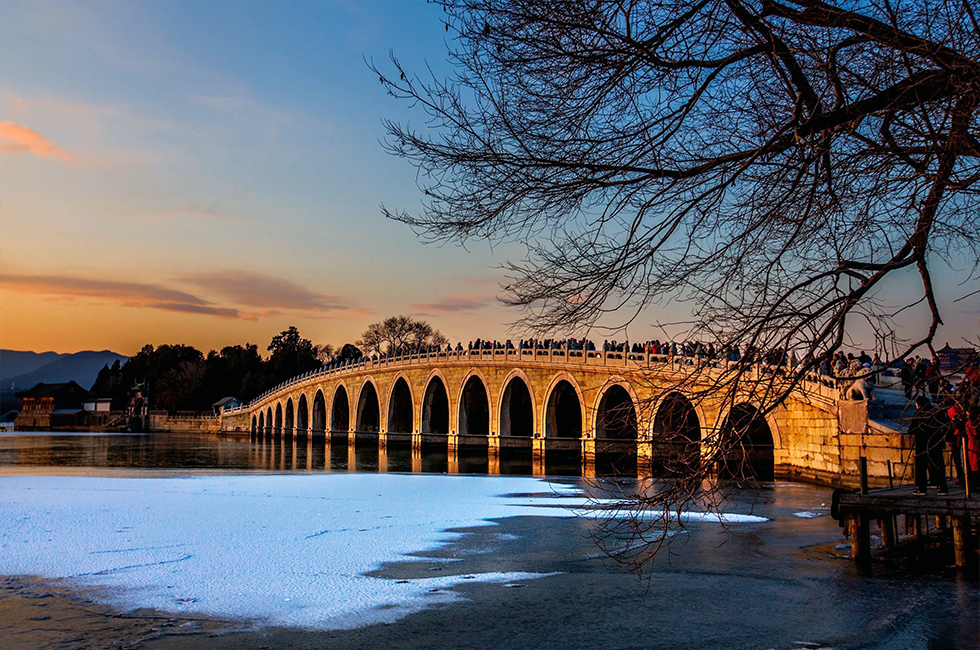 The 17-Arch Bridge
The 17-Arch Bridge9. The 17-Arch Bridge: Reposing on the Kunming Lake, the 17-Arch Bridge is the largest stone bridge connecting the East Causeway and the Nanhu Isle. It is 8 meters wide and 150 meters long, composed of 15 arches. The stone railings on both sides of the bridge are carved with over 500 lions of different sizes and shapes.
10. The Marble Boat: The Marble Boat is a large stone boat by the lakeside at the western side of the Long Corridor serves as a symbol of peace and tranquility. As the only Western-style architecture in the Summer Palace, it used to be a terrace of the Yuanjing Temple of the Ming Dynasty where people
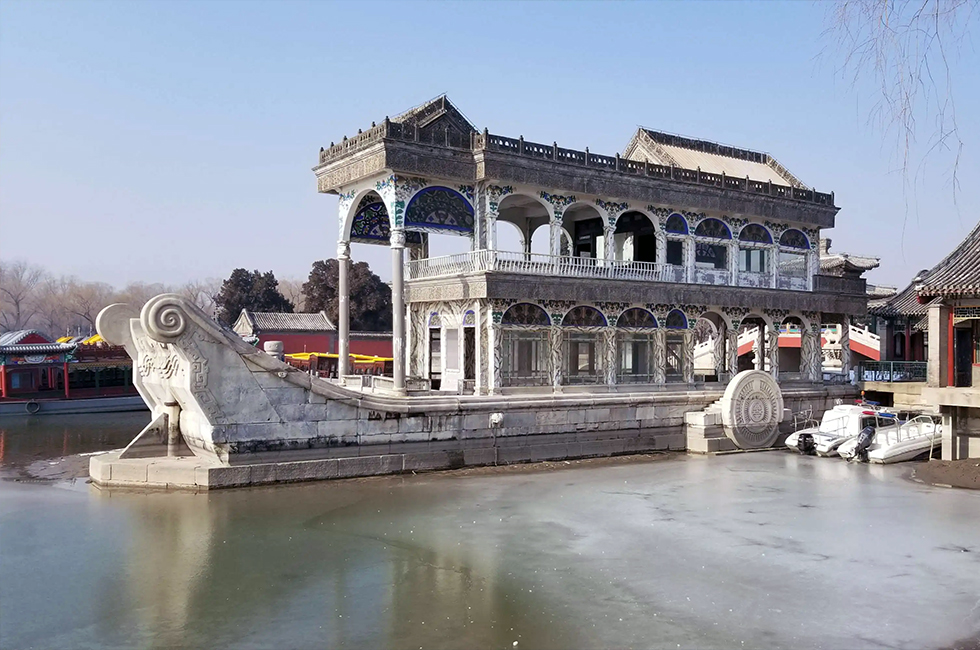 The Marble Boat
The Marble Boat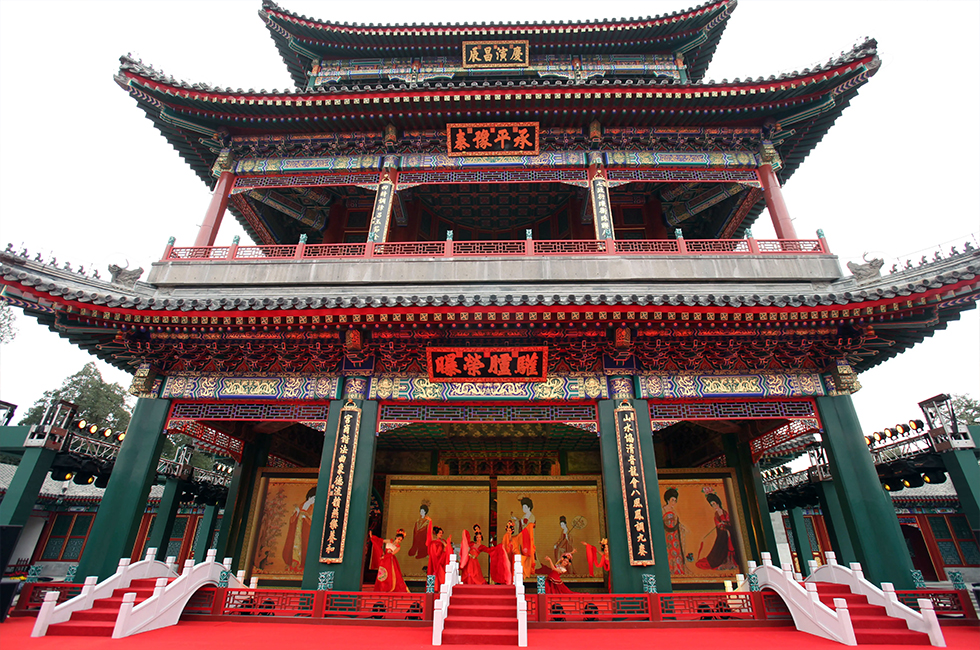 The Opera Hall
The Opera Hall11. The Opera Hall: Located at Dehe Garden, the Opera House Hall is known as one of three most famous opera house in the Qing Dynasty, the other two being Qingyin Hall of Chengde Summer Resort and Changyin Hall of the Forbidden City. The Opera Hall was built for celebrating the 60th birthday of Empress Dowager Cixi. The opera performances used to be solely staged for her in her birthday celebrations. The 21-meter-tall hall is next only to the Tower of Buddhist Incense in height. The hall has two stories, with two stories in the backstage as the dressing area. On the top of the ceiling there is a “heavenly well,” which is used to achieve a lighting effect. In the base of the stage there is a well and five square ponds. When the scene involves characters such as immortals and ghosts, the performers can either fly down from the “heavenly well” or make their appearance from the well on the ground. When necessary, water is pumped to the stage from the pond.
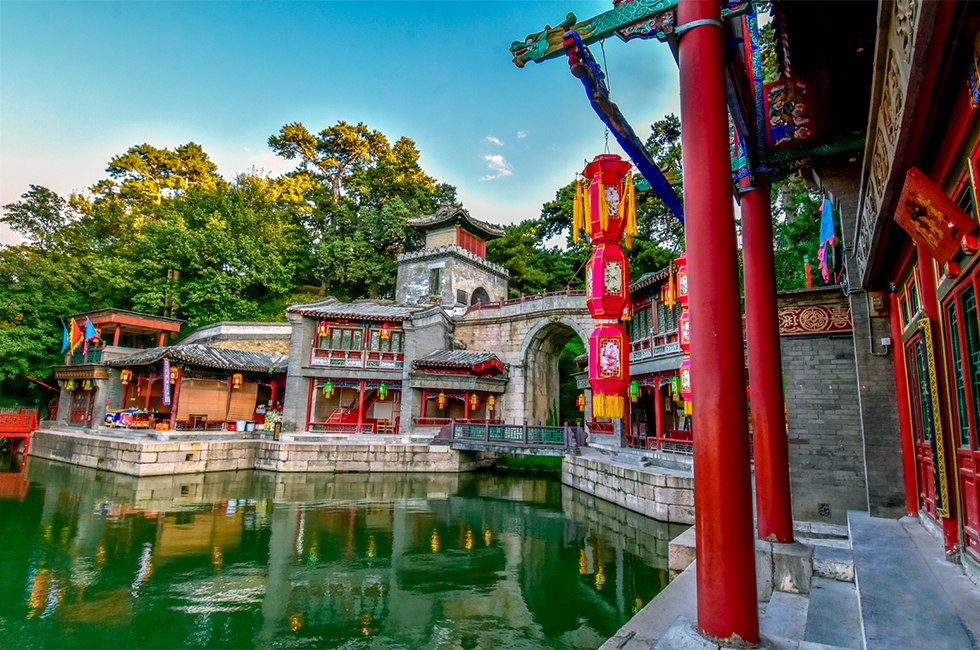 Suzhou Street
Suzhou Street12. Suzhou Street: It is a commercial street that mimics the water town in the lower regions of the Yangtze River. Back in the Qing Dynasty, the street was home to a multitude of stores and shops, such as jade antique store, silk store, snack store, teahouse and jewelry store. When emperors passed this street, the maidens and eunuchs acted store owners and opened the stores. More than ten stores by the bank of Back Lake was burnt down by foreign aggressors in 1860. The stores we see today were revamped in 1986.
 The Baoyun Bronze Pavilion
The Baoyun Bronze Pavilion13. The Coppery Pavilion (The Baoyun Bronze Pavilion): It is one of the most exquisite and the heaviest coppery art pieces in China. Built during the reign of Emperor Qianlong, it is a 7.5-meter-tall structure quietly reposing on a 4-meter-tall marble base in Wufang Pavilion at the western side of the Tower of Buddhist Incense, weighing 207 tons. On the four sides of the pavilion there are four rhombus-shaped fans. Though it has a coppery structure, the architectural techniques follow the standards of a wooden structure. On its eastern, southern and western sides are three 4-lattice doors, while on its northern side is a 8-lattice window. The doors and windows are all carved with patterns of rhombus, and the same applies to the curtain frame. All the lattices have both interior and exterior layers.
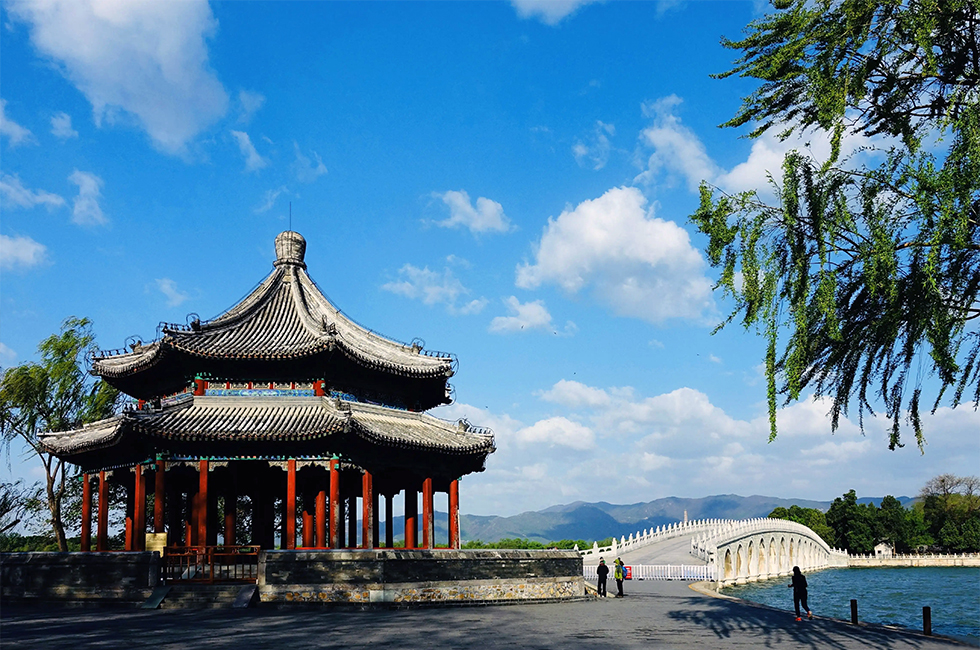 Wandering in the Painting
Wandering in the Painting14. Wandering in the Painting: Wandering in the Painting refers to a set of major architectures on the western side of the Longevity Hill. Built according to the actual geographic conditions, it has a 2-story mansion in its front, flanked by two buildings, namely Aishan Mansion and Jieqiu Mansion. Behind the mansion stands a stone archway, behind which lies Chenghui Hall. The buildings are connected to one another with ascending corridors. The architectural styles of the buildings at the middle of the hill are indeed diverse. Mansions, halls and corridors are scattered at different altitudes of the hill. From a distance, the architectural structure covered with red, yellow, blue and green glazed tiles just loom in the verdant forest, resembling a traditional Chinese painting.
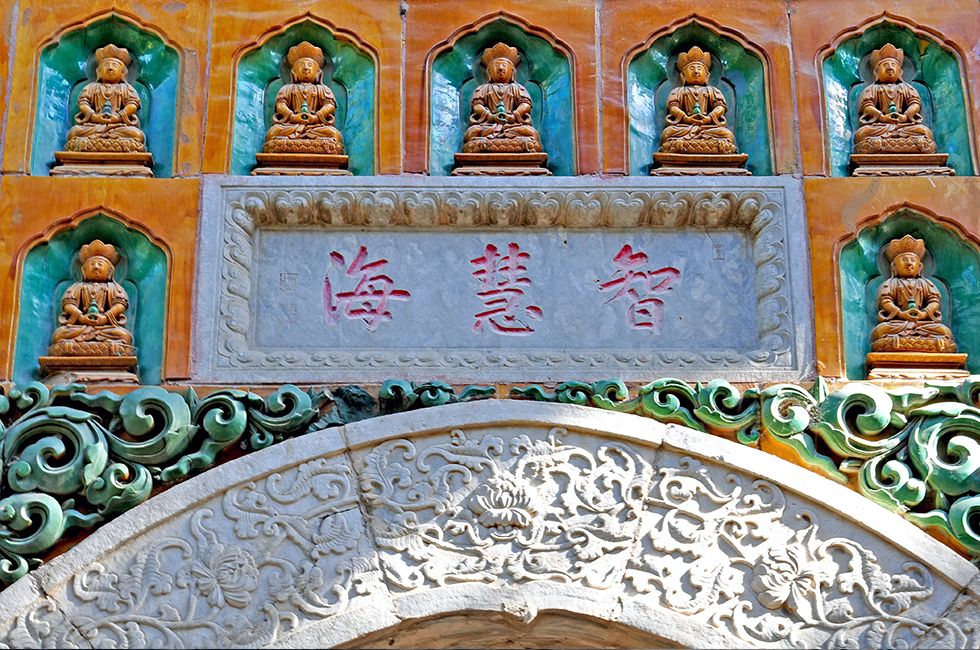 The Wisdom Hall
The Wisdom Hall15. The Wisdom Hall: It is a religious building on the highest point of the Longevity Hill. Its exterior is decorated with exquisite yellow and green glazed tiles, with few purple and blue glazed tiles being used to decorate the roof top. The bright colors just contribute to the magnificence of the hall. The name Wisdom Hall comes from Buddhist terminologies, indicating that the wisdom of Buddha is as boundless as the sea. Although it appears like a wooden structure, it is indeed constructed with bricks and stones without any use of wood materials. Since it has no beams to share the burden from the roof, it is also called a hall without a beam. Inside the hall the statue of Buddha Amitābha is worshipped.
 The Coppery Ox
The Coppery Ox16. The Coppery Ox: It is on the eastern side of the Kunming Lake and the northern side of the 17-Arch Bridge. Originally forged in 1755 for flood control and prevention, it is also referred to as the golden ox.
17. The Hall of Jade Ripples: It is a courtyard enclosed in three directions (with three rooms in three different directions), erected by lakeside to the southwest of the Hall of Benevolence and Longevity.
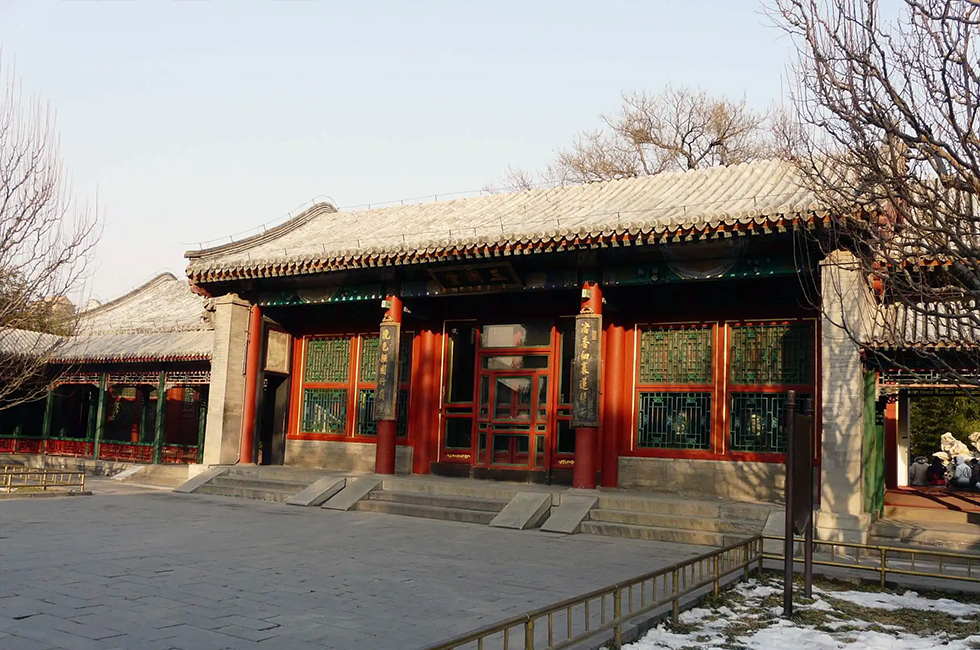 The Hall of Jade Ripples
The Hall of Jade Ripples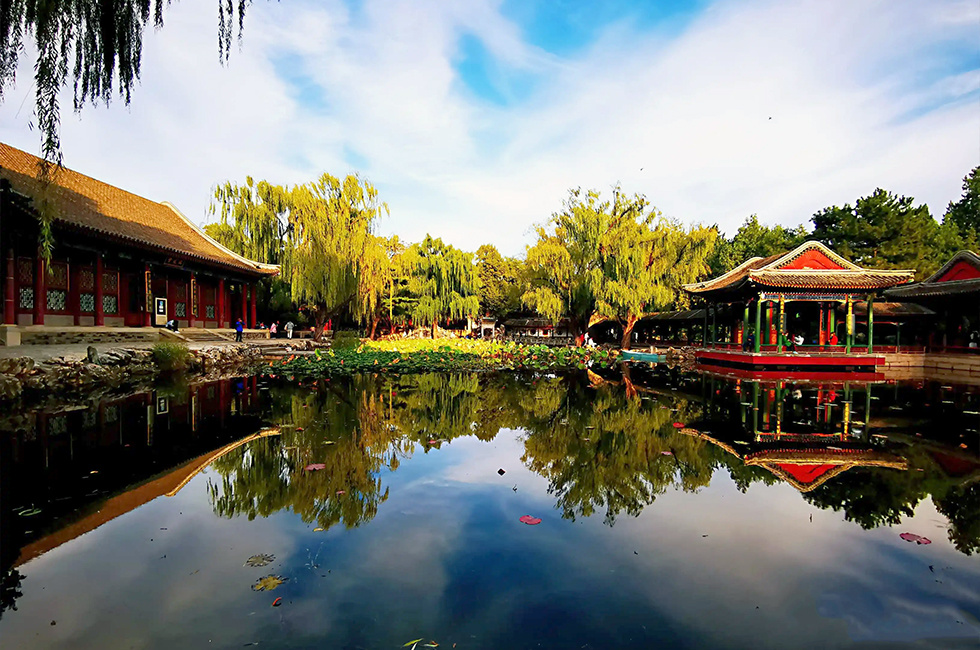 The Garden of Harmonious Pleasures
The Garden of Harmonious Pleasures18. The Garden of Harmonious Pleasures: Located at the eastern foot of the Longevity Hill, it is a garden amid gardens featuring the garden design of the southern style, isolated from all other buildings. Its architectural style mimics Jichang Garden of Wuxi in Jiangsu Province. First called Huishan Garden, it was renovated in 1911 and given the name-the Garden of Harmonious Pleasures. Indeed, this name was inspired by two poems, one of which was composed by Emperor Qianlong. Inside the garden there are 13 pavilions, terraces and halls, all of which are connected by many corridors and five bridges of various styles. In the southeastern corner of the garden there is a stone bridge, the archway of which is inscribed with three Chinese characters penned by Emperor Qianlong.
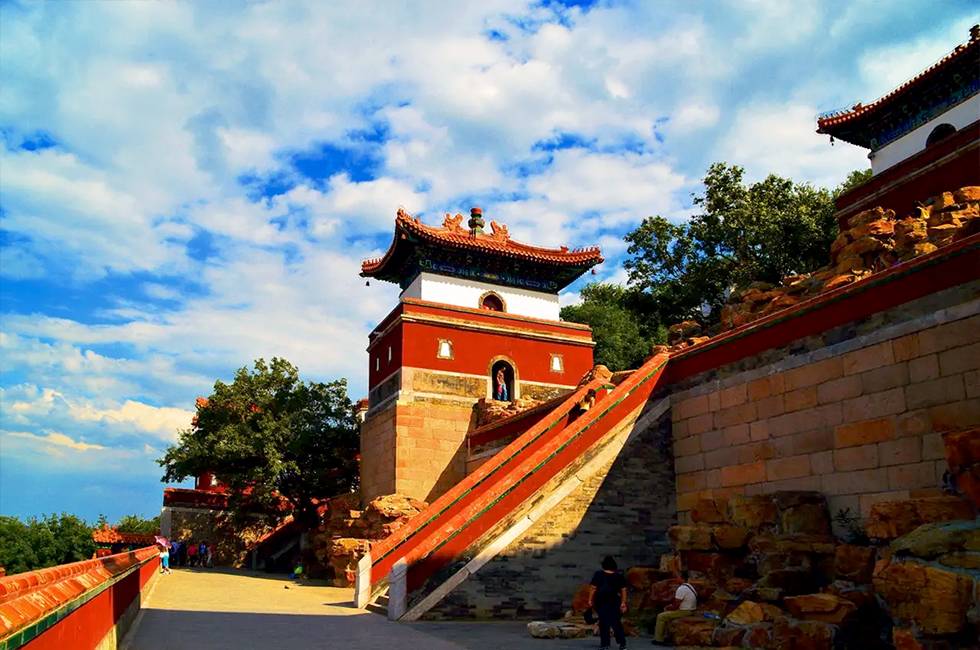 The Four Major Divisions of the Terrestrial Sphere
The Four Major Divisions of the Terrestrial Sphere19. The Four Major Divisions of the Terrestrial Sphere: Located at the middle of the back of the Longevity Hill, it is an architectural ensemble featuring a fusion of the Tibetan and Han architectural styles. With an area of 20,000 square meters, it is built according to the actual geographic conditions. In its front there used to be a large architectural complex called Mixulingjing (now it’s only a platform); on its both sides are 3-meter-tall Dharani pillars; at its back is Xianyan Zongyin Hall-the main structure of the temple ensemble. The buildings in its four directions symbolize the four major divisions of the terrestrial sphere upheld in Buddhism, including the eastern continent, the western continent, the southern continent and the northern continent. Also, there are also other eight smaller continents composed of towers with various styles. On the southern, southwestern, northeastern and northwestern sides stand four red, white, black and green lama pagodas representing four types of wisdom in the Buddhist sutra. On each side of the pagoda encircle 13 wheels, which represent the 13 different levels of heaven in the Buddhist sutra. The pagodas are uniquely designed, solemn yet elegant. Between the four “continents” and the eight smaller ones, there are two terraced halls that are not at the same height. One represents the sun while the other the moon, indicating that the glows of the sun and the moon encircle Buddha.
GREAT FAMILY CHINA TOUR
JULY 2024 We wanted to thank Grace at China Culture tour for organizing a great tour of China. We enjoyed our Beijing - Xian-Chengdu -Guilin -Yangshuo - Shanghai trip. Our local guides Bruce in Beijing, Susan in Xian, Jane in Chengdu, Mike in Guilin and Mary in Shanghai took care of us…read more details »
Teng Han L from SINGAPORE
Ready to Create a Unique Dream Travel?
